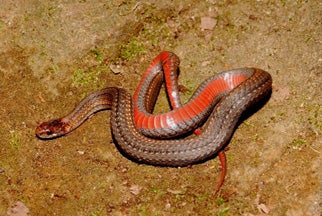SCIENTIFIC NAME:
Storeria occipitomaculata occipitomaculata
OTHER NAMES:
Red-bellied snake
STATUS:
Fairly common statewide. Believed to be declining in many areas. Lowest Conservation Concern.
DESCRIPTION:
This species is a small snake, typically less than 16 inches, with a blunt head. The color of this snake is highly variable, its back could be gray, brown and less commonly black and the head may be a different color altogether. On the neck are typically three spots, though they may fuse and appear as a collar. The coloration of the belly is often in stark contrast with the rest of the snake; as suggested by the species’ common name, the belly is typically red but may also appear pink or orange. Scales are keeled.
DISTRIBUTION:
The species ranges throughout the eastern portion of North America, generally east of the Dakotas in the north and Texas in the South. It’s likely they occur in every county in Alabama.
HABITAT:
This snake can be found hiding under leaf litter, logs, and other cover objects within hardwood forests and around wetland edges. They prefer mesic forested habitats that are relatively moist and well shaded, with moderately heavy soils.
FEEDING HABITS:
Red-bellied snakes eat primarily invertebrates; slugs and worms are important food items.
LIFE HISTORY AND ECOLOGY:
As a small, leaf-litter dwelling species, they are vulnerable to predation by a wide range of animals, ranging from birds to toads. Females give birth to live young once a year, litters average about eight individuals. Although secretive and rarely seen, this is likely a locally abundant species in suitable habitat.
REFERENCES:
Ernst, C. H. and E. M. Ernst. 2003. Snakes of the United States and Canada. Smithsonian Institution Press, Washington, D. C.
Mount, R. 1975. The Reptiles & Amphibians of Alabama. Auburn Printing Co., Auburn, AL. 347 pp.
AUTHOR:
David A. Steen, Ph.D. Candidate, Auburn University






